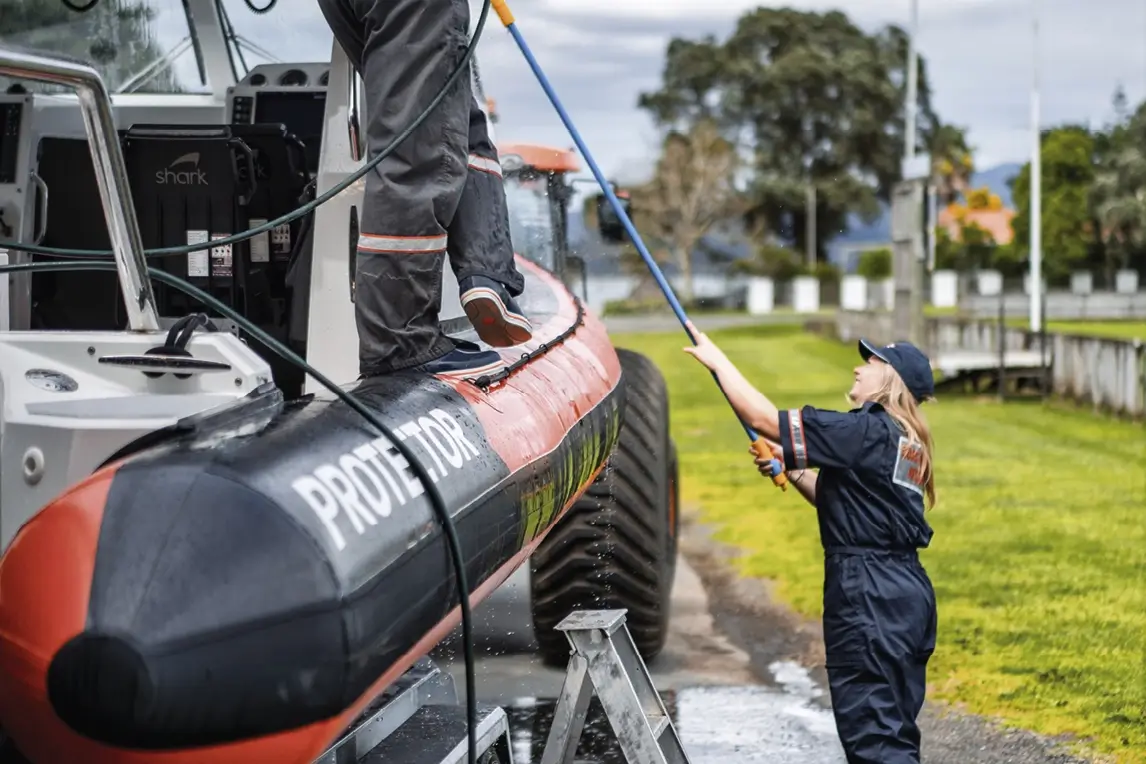Home » All Issues » Issue 4 » Comitted to the Coast
Comitted to the Coast
Whitianga Coastguard Volunteers
THE UNSUNG HEROES OF WHITIANGA
Crystal clear waters framed by towering cliff faces is the best way to describe Whitianga. Situated on the northern end of the Coromandel Peninsula, the small town boasts pristine beaches and sacred caves, making it the perfect tourist attraction.
The beaches are among the best in the world, but they can also be extremely dangerous. This sentiment is familiar to Graham Caddy, who has been a Whitianga Coastguard volunteer for 12 years. “We’re on a peninsula with our eastern seaboard completely exposed. There’s nothing between us and Argentina, so as you can imagine, we get some changeable weather,” Graham explains. “On a good day it’s paradise, but on a bad day it’s treacherous – that pretty much sums up our coast.”
The Whitianga Coastguard is the second busiest unit in the eastern region of New Zealand, looking after the body of water stretching from Cape Colville in the north to Boat Harbour in the south. The local population of 7,000 expands to roughly 40,000 people over the summer period.
Dedicated coastguard volunteers are responsible for ensuring every visitor can enjoy Aotearoa’s waters safely. From the busy summer rush to the quiet off-season and every day in between, the job calls for 100 per cent dedication to their practice. “Our program is different to typical volunteer programs. We’ve got crews on call 24 hours a day,” Graham says. The training and commitment required makes the role a number one priority and is why Graham coined the term ‘professional volunteer’. “We might not get paid, but there’s a lot of work that goes into being a coastguard. Our training alone is a structured regime, and it can take up to 18 months before a volunteer becomes qualified crew.”
The coastguard is open to all walks of life; anyone can become a volunteer. “We take people from zero to hero with our training, so they don’t need a background in boating,” Graham notes. “But it’s a big commitment to make. We make it clear that part of being a professional volunteer means there are requirements and expectations, and not everybody can live up to those.”



The vigorous training isn’t wasted. Crews find themselves on the front line, responding to incidents off the coast, including missing people and suspected drownings. For Graham, this can be both the hardest and the most rewarding part of the job. “It can be challenging conducting a search under extreme pressure and coordinating all the aspects that come with it, especially with the vastness of the ocean and the urgency of time. It can really take a toll, with all the uncertainty and adrenaline pumping through you,” he reflects.
“A successful outcome is always the best part of our job and what we work so hard for.” The hard work is evident. The Whitianga team currently have a 100 per cent recovery rate.
Whitianga Coastguard’s role in the community recently extended beyond saving lives. In 2019, the team launched a cadet program to teach valuable life skills to local teenagers. “The 12-week program offers a window into life as a coastguard volunteer for students aged between 15 and 17 years. This includes theory training about survival skills and rescue techniques, but mainly practical work on the boats,” Graham explains.
“It’s not designed to make recruits of cadets; it’s to give them life skills and teach them the value of teamwork, which is important.
“The Whitianga Coastguard Unit has a strong community, with 25 wet crew, 12 radio operators and four dry crew volunteers, as well as the 10 cadets coming through the program each year. We have a fantastic and capable team, but it’s critical we have the right equipment to support our operations.” In a job where there is no room for error, Whitianga Coastguard relies on Kubota M8540 and M9540 tractors.
“We don’t leave our boats on the water. We’ve got a sizable boat shed here. The Kubota tractors allow us to quickly launch and retrieve the boats safely,” Graham explains. “After seeing how vital our first tractor was, we didn’t hesitate to purchase another. “The tractor tows the boats to and from the marina ramp. It’s all about the launch and retrieval. If we didn’t have the appropriate tractors, it wouldn’t be safe, as it’s quite a steep ramp. We need that power, which is where Kubota delivers.”
"I WAS TOLD IT COULDN’T BE DONE... BUT IT CAN BE DONE"

When it was time to invest in their second tractor, the Whitianga team turned to the Central Motors dealership, who provided a solution to every challenge.
“We told them what we needed, and they produced a tractor with the necessary equipment, including custom tyres,” Graham recalls. “Both of our 9m rescue vessels have a different type of trailer with different requirements. We basically gave a shopping list to the Central Motors team, and they delivered the goods.”
For locals, Kubota is a household name due to Whitianga hosting the annual Kubota Billfish Classic – the largest billfish tournament in the world. Each year people from across New Zealand enter for their chance at more than $1.5 million in prizes. “The competition is getting bigger and bigger, which is great for Whitianga. Knowing the Kubota product also delivers is even better,” Graham remarks.
Reflecting on his time as a coastguard, Graham sees the community of Whitianga as his biggest inspiration for continuing. “Using the skills I’ve built over the years alongside a team of committed volunteers is amazing.”


